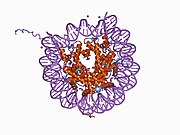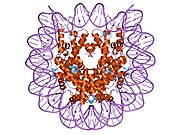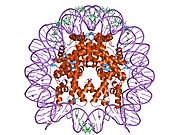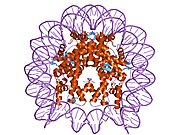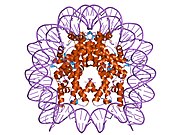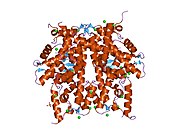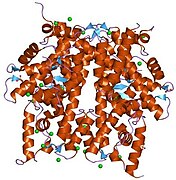| H2BC11 | |||||||||||||||||||||||||||||||||||||||||||||||||||
|---|---|---|---|---|---|---|---|---|---|---|---|---|---|---|---|---|---|---|---|---|---|---|---|---|---|---|---|---|---|---|---|---|---|---|---|---|---|---|---|---|---|---|---|---|---|---|---|---|---|---|---|
 | |||||||||||||||||||||||||||||||||||||||||||||||||||
| |||||||||||||||||||||||||||||||||||||||||||||||||||
| Identifiers | |||||||||||||||||||||||||||||||||||||||||||||||||||
| Aliases | H2BC11, H2B/r, H2BFR, H2BJ, histone cluster 1, H2bj, histone cluster 1 H2B family member j, H2B clustered histone 11, HIST1H2BJ | ||||||||||||||||||||||||||||||||||||||||||||||||||
| External IDs | OMIM: 615044; MGI: 2448415; HomoloGene: 128594; GeneCards: H2BC11; OMA:H2BC11 - orthologs | ||||||||||||||||||||||||||||||||||||||||||||||||||
| |||||||||||||||||||||||||||||||||||||||||||||||||||
| |||||||||||||||||||||||||||||||||||||||||||||||||||
| |||||||||||||||||||||||||||||||||||||||||||||||||||
| |||||||||||||||||||||||||||||||||||||||||||||||||||
| |||||||||||||||||||||||||||||||||||||||||||||||||||
| Wikidata | |||||||||||||||||||||||||||||||||||||||||||||||||||
| |||||||||||||||||||||||||||||||||||||||||||||||||||
Histone H2B type 1-J is a protein that in humans is encoded by the HIST1H2BJ gene.
Histones are basic nuclear proteins that are responsible for the nucleosome structure of the chromosomal fiber in eukaryotes. Two molecules of each of the four core histones (H2A, H2B, H3, and H4) form an octamer, around which approximately 146 bp of DNA is wrapped in repeating units, called nucleosomes. The linker histone, H1, interacts with linker DNA between nucleosomes and functions in the compaction of chromatin into higher order structures. This gene is intronless and encodes a member of the histone H2B family. Transcripts from this gene lack polyA tails but instead contain a palindromic termination element. This gene is found in the histone microcluster on chromosome 6p21.33.
References
- ^ GRCh38: Ensembl release 89: ENSG00000124635 – Ensembl, May 2017
- ^ GRCm38: Ensembl release 89: ENSMUSG00000068854 – Ensembl, May 2017
- "Human PubMed Reference:". National Center for Biotechnology Information, U.S. National Library of Medicine.
- "Mouse PubMed Reference:". National Center for Biotechnology Information, U.S. National Library of Medicine.
- Zhong R, Roeder RG, Heintz N (Jan 1984). "The primary structure and expression of four cloned human histone genes". Nucleic Acids Res. 11 (21): 7409–7425. doi:10.1093/nar/11.21.7409. PMC 326492. PMID 6647026.
- Marzluff WF, Gongidi P, Woods KR, Jin J, Maltais LJ (Oct 2002). "The human and mouse replication-dependent histone genes". Genomics. 80 (5): 487–498. doi:10.1016/S0888-7543(02)96850-3. PMID 12408966.
- ^ "Entrez Gene: HIST1H2BJ histone cluster 1, H2bj".
Further reading
- Alnemri ES, Litwack G (1989). "Glucocorticoid-induced lymphocytolysis is not mediated by an induced endonuclease". J. Biol. Chem. 264 (7): 4104–11. doi:10.1016/S0021-9258(19)84968-2. PMID 2917990.
- Frohm M, Gunne H, Bergman AC, et al. (1996). "Biochemical and antibacterial analysis of human wound and blister fluid". Eur. J. Biochem. 237 (1): 86–92. doi:10.1111/j.1432-1033.1996.0086n.x. PMID 8620898.
- Albig W, Doenecke D (1998). "The human histone gene cluster at the D6S105 locus". Hum. Genet. 101 (3): 284–294. doi:10.1007/s004390050630. PMID 9439656. S2CID 38539096.
- El Kharroubi A, Piras G, Zensen R, Martin MA (1998). "Transcriptional activation of the integrated chromatin-associated human immunodeficiency virus type 1 promoter". Mol. Cell. Biol. 18 (5): 2535–44. doi:10.1128/mcb.18.5.2535. PMC 110633. PMID 9566873.
- Albig W, Trappe R, Kardalinou E, et al. (1999). "The human H2A and H2B histone gene complement". Biol. Chem. 380 (1): 7–18. doi:10.1515/BC.1999.002. PMID 10064132. S2CID 12807248.
- Ahn J, Gruen JR (1999). "The genomic organization of the histone clusters on human 6p21.3". Mamm. Genome. 10 (7): 768–770. doi:10.1007/s003359901089. PMID 10384058. S2CID 28275496.
- Deng L, de la Fuente C, Fu P, et al. (2001). "Acetylation of HIV-1 Tat by CBP/P300 increases transcription of integrated HIV-1 genome and enhances binding to core histones". Virology. 277 (2): 278–295. doi:10.1006/viro.2000.0593. PMID 11080476.
- Deng L, Wang D, de la Fuente C, et al. (2001). "Enhancement of the p300 HAT activity by HIV-1 Tat on chromatin DNA". Virology. 289 (2): 312–326. doi:10.1006/viro.2001.1129. PMID 11689053.
- Galasinski SC, Louie DF, Gloor KK, et al. (2002). "Global regulation of post-translational modifications on core histones". J. Biol. Chem. 277 (4): 2579–2588. doi:10.1074/jbc.M107894200. PMID 11709551.
- Weinmann AS, Yan PS, Oberley MJ, et al. (2002). "Isolating human transcription factor targets by coupling chromatin immunoprecipitation and CpG island microarray analysis". Genes Dev. 16 (2): 235–244. doi:10.1101/gad.943102. PMC 155318. PMID 11799066.
- Kim HS, Cho JH, Park HW, et al. (2002). "Endotoxin-neutralizing antimicrobial proteins of the human placenta". J. Immunol. 168 (5): 2356–64. doi:10.4049/jimmunol.168.5.2356. PMID 11859126.
- Strausberg RL, Feingold EA, Grouse LH, et al. (2003). "Generation and initial analysis of more than 15,000 full-length human and mouse cDNA sequences". Proc. Natl. Acad. Sci. U.S.A. 99 (26): 16899–16903. Bibcode:2002PNAS...9916899M. doi:10.1073/pnas.242603899. PMC 139241. PMID 12477932.
- Giampuzzi M, Oleggini R, Di Donato A (2003). "Demonstration of in vitro interaction between tumor suppressor lysyl oxidase and histones H1 and H2: definition of the regions involved". Biochim. Biophys. Acta. 1647 (1–2): 245–51. doi:10.1016/s1570-9639(03)00059-1. PMID 12686141.
- Cheung WL, Ajiro K, Samejima K, et al. (2003). "Apoptotic phosphorylation of histone H2B is mediated by mammalian sterile twenty kinase". Cell. 113 (4): 507–517. doi:10.1016/S0092-8674(03)00355-6. PMID 12757711. S2CID 21854.
- Tollin M, Bergman P, Svenberg T, et al. (2004). "Antimicrobial peptides in the first line defence of human colon mucosa". Peptides. 24 (4): 523–530. doi:10.1016/S0196-9781(03)00114-1. PMID 12860195. S2CID 7435936.
- Mungall AJ, Palmer SA, Sims SK, et al. (2003). "The DNA sequence and analysis of human chromosome 6". Nature. 425 (6960): 805–811. Bibcode:2003Natur.425..805M. doi:10.1038/nature02055. PMID 14574404.
- Lusic M, Marcello A, Cereseto A, Giacca M (2004). "Regulation of HIV-1 gene expression by histone acetylation and factor recruitment at the LTR promoter". EMBO J. 22 (24): 6550–6561. doi:10.1093/emboj/cdg631. PMC 291826. PMID 14657027.
- Howell SJ, Wilk D, Yadav SP, Bevins CL (2004). "Antimicrobial polypeptides of the human colonic epithelium". Peptides. 24 (11): 1763–1770. doi:10.1016/j.peptides.2003.07.028. PMID 15019208. S2CID 28953527.
This article on a gene on human chromosome 6 is a stub. You can help Misplaced Pages by expanding it. |




